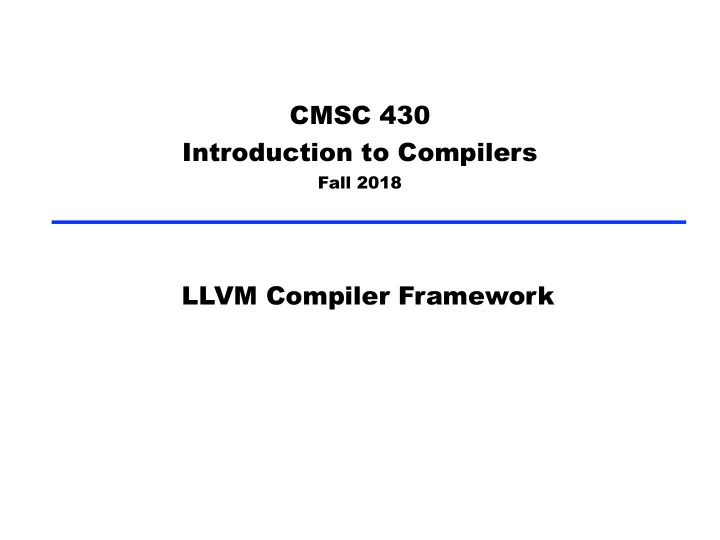

CMSC 430 Introduction to Compilers Fall 2018 LLVM Compiler Framework
Overview • We’ve focused on building a compiler, end to end • In practice, there are a lot of tools we can leverage • Today we’ll discuss one of the most popular: LLVM ■ Introduction to the framework ■ Tour of the IR ■ Using command-line tools ■ Writing optimization passes ■ Using and extending the static analyzer ■ Symbolic execution with Klee 2
LLVM Overview • From http://llvm.org/: “The LLVM Project is a collection of modular and reusable compiler and toolchain technologies.” • Started in 2000 as a research project at the University of Illinois (Lattner and Adve) ■ Still actively used in compiler and PL research • Has grown into an industrial scale collection of compilers, libraries, and tools ■ Used and supported by Apple, Adobe, Intel, etc. • Written in C++, well-documented 3
Compiler architecture • Specialized parsers (frontends) and code generators (backends), common optimizers http://www.aosabook.org/en/llvm.html 4
Getting LLVM • The project changes frequently ■ And contains a lot of code • Typically, build from source ■ But this can take a while… • Binary distributions are also available • Macs ship with a subset, installed with Xcode ■ In particular, clang/clang++ (aliased as gcc) 5
LLVM IR • Low-level, similar to RISC-like assembly ■ With enough structure to see high-level features • Strongly-typed: every value has a type ■ includes support for structures • Infinite temporary registers • SSA -- static single assignment ■ Can only assign to each variable once ■ Simplifies program analysis http://llvm.org/docs/LangRef.html 6
int add(int a, int b) { return a + b; } clang -S add.c -emit-llvm -o add.ll ; Function Attrs: noinline nounwind optnone ssp uwtable define i32 @add(i32, i32) #0 { %3 = alloca i32, align 4 %4 = alloca i32, align 4 store i32 %0, i32* %3, align 4 store i32 %1, i32* %4, align 4 %5 = load i32, i32* %3, align 4 %6 = load i32, i32* %4, align 4 %7 = add nsw i32 %5, %6 ret i32 %7 }
LLVM Tools • Three IR formats: ASCII (.ll), Bitcode (.bc), and in- memory representation • clang/clang++: compile C to LLVM IR (different frontends for other high-level languages) • llvm-as: translate .ll into .bc • llvm-dis: convert back from .bc to .ll • llvm-link: combine multiple .bc files • lli: interpreter and dynamic compiler • llc: .bc to native assembly (.s) • opt: LLVM optimizer/analyzer https://llvm.org/docs/CommandGuide/ 8
opt tool • opt can be used for both optimization and analysis ■ loop.c example: -O3 , -analyze -loops • Extensible via DLLs ■ Can write new analyses as “passes” opt -load LLVMHello.dylib -hello funcs.ll ■ http://llvm.org/docs/WritingAnLLVMPass.html#quick-start-writing-hello-world 9
Static Analyzer • LLVM can be used to build static analysis tools, e.g., http://clang-analyzer.llvm.org/ void test(int z) { if (z == 0) { int x = 1 / z; } } $ scan-build clang -c div0.c scan-build: Using 'clang-7' for static analysis div0.c:3:9: warning: Value stored to 'x' during its initialization is never read int x = 1 / z; ^ ~~~~~ div0.c:3:15: warning: Division by zero int x = 1 / z; ~~^~~ 2 warnings generated. scan-build: 2 bugs found. 10
Address Sanitizer • LLVM/clang can be used to implement runtime instrumentation for safety, performance measurement, etc. • https://clang.llvm.org/docs/AddressSanitizer.html int main(int argc, char **argv) { int *array = new int[100]; delete [] array; return array[argc]; // BOOM } clang++ -O1 -g -fsanitize=address -fno-omit-frame-pointer UseAfterFree.cc ================================================================= ==65223==ERROR: AddressSanitizer: heap-use-after-free on address 0x614000000044 at pc… READ of size 4 at 0x614000000044 thread T0 #0 0x108d6af07 in main UseAfterFree.cc:4 #1 0x7fff67e3a014 in start (libdyld.dylib:x86_64+0x1014) 11
Klee: Symbolic Execution http://klee.github.io/tutorials/testing-function/ 12
Recommend
More recommend